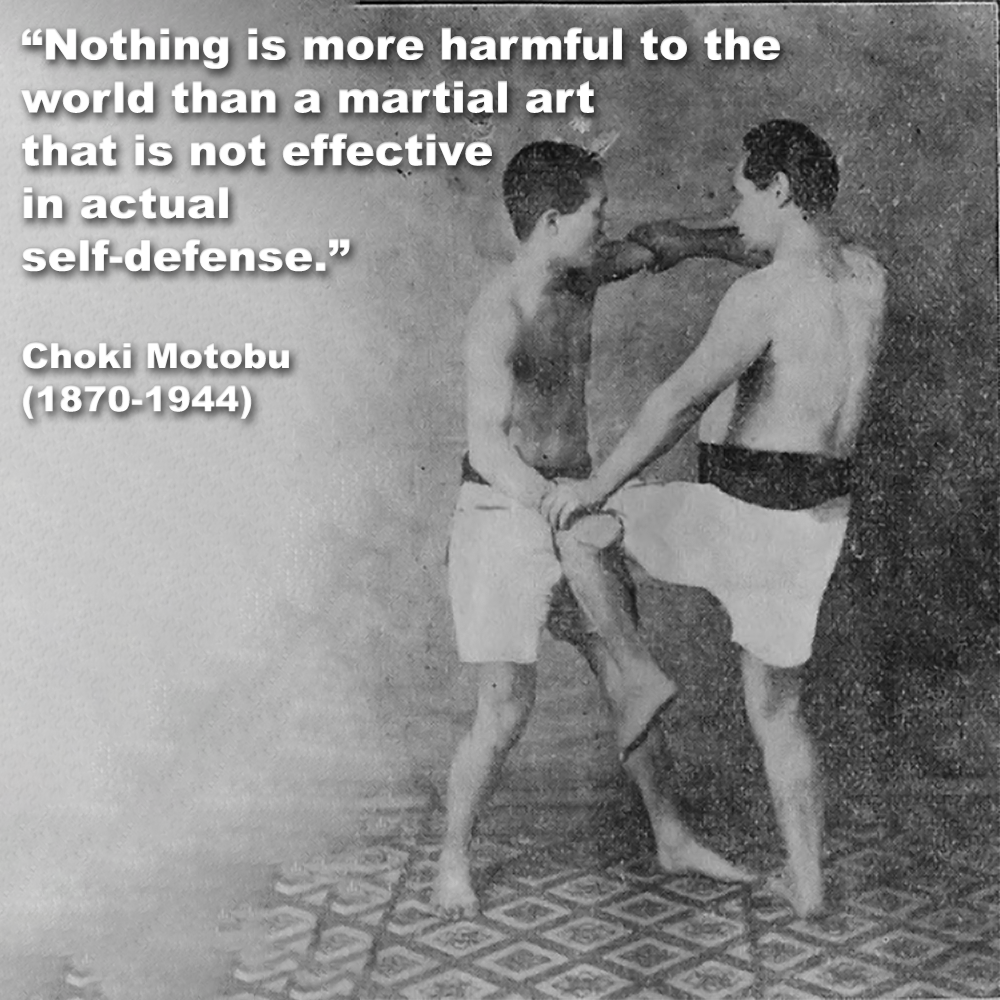
It is said that the Okinawan karate pioneers, Gichin Funakoshi (1868-1957) and Choki Motobu (1870-1944), did not agree on many things and openly disliked each other.
.
Funakoshi became an advocate of Karate-do, while Motobu, an advocate of Karate-jutsu.
.
Motobu in his criticism of Funakoshi, stated that; “Nothing is more harmful to the world than a martial art that is not effective in actual self-defense.”
.
From the earliest records we have the enhancement of moral character of a student, which was a key part of karate.
.
It is true that the measure of a martial artist should encompass the essential values. But these values of respect, loyalty, self-discipline, indomitable spirit, integrity and more, on their own, are of no use when practical skills are needed most.
.
Today, even though many karate dojo call themselves traditional, mostly we have a modern system that has little to do with real self-defense or combat.
.
Karate as it is commonly practiced today, is to a greater extent, competition, tournament or sport oriented. Most practitioners have either never used their practices for real world self-defense (which is preferable), or never wished to, having only practiced within the conditioned environment of the dojo, or sports arena.
.
In many schools there is often a distinction made between the followers of Karate-do and Karate-jutsu.
.
Karate-do would ultimately be the practice of karate in order to develop the “character of its participants” (Funakoshi).
.
Karate-jutsu could be thought of as the application of karate in real situations.
.
While often used interchangeably, the key difference lies in the very essence of their names. “Do” translates to “way,” or “path”, emphasizing the spiritual and philosophical aspects of karate.
.
Karate-do seeks to cultivate self-improvement, self-discipline, and character development through rigorous training and ethical principles. It prioritizes personal growth over pure combat effectiveness.
.
In contrast, “jutsu” translates to “art” or “technique,” usually this term is used to emphasize the practical application of karate for self-defense and combat, honed for real-world confrontations.
.
Despite their philosophical differences, karate-do and karate-jutsu share a common foundation.
.
Both share a rich cultural heritage rooted in Okinawan history and tradition. They carry the legacy of past masters who honed their skills not just for combat, but for self-defense and the protection of their communities.
.
In the modern world, the lines between karate-do and karate-jutsu are increasingly blurring…… And rightly so, many styles incorporate elements of both philosophies, seeking to develop both the inner and outer aspects of practitioners.
.
This reflects a growing understanding that true self-defense goes beyond physical prowess, encompassing mental resilience, emotional control, and the ability to avoid conflict altogether.
.
By understanding their differences and appreciating their similarities, we gain a deeper appreciation for the rich tapestry of karate. And that the true essence of this art lies not in a single path.
.
While mastering self-defense (jutsu) is essential, the art blossoms when paired with self-mastery (do). Through rigorous practice and introspection, each movement illuminates strengths and weaknesses, crafting not just a skilled fighter, but a refined character.
.
Itosu Ankoh was noted for saying that: “Karate strives to build character, improve human behaviour, encourage modesty. However, by virtue of its practice, Karate cannot and does not guarantee it.”
.
Therefore, the true karate-ka becomes a practitioner with a purpose, wielding skills not just for personal defense, but for shaping something more meaningful.
.
.
